Japanese banana (Musa basjoo) Non-Native
Japanese banana (Musa basjoo)
Otherwise known as Japanese fiber bananas, they are cold hardy and can be grown in most any climate. Their fruit is inedible. The nectar of the flowers is sweet and drinkable.
Medicinal uses: The roots are diuretic, febrifuge and sialagogue. A decoction is used in the treatment of beriberi, constipation, jaundice, dropsy, restlessness due to heat, leucorrhoea and croton bean poisoning. The leaves are diuretic.
Other uses: A fiber is obtained from the leaf stems. Used for cloth, sails etc. The fiber can also be used for making paper. The leaves are harvested in summer and are soaked in water for 24 hours prior to cooking. The fibers are cooked for 2 hours with lye and then beaten in a ball mill for 4½ hours before being made into paper (www.ibiblio.org).
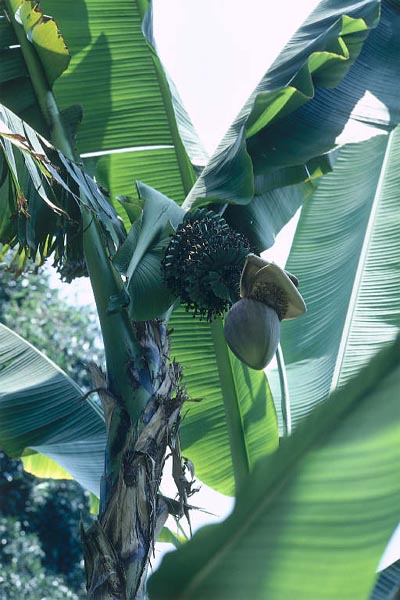
Pacific Northwest Medicinal Plant Guide (Check out all plants growing in Tryon Farm's medicinal garden!)
- Login to post comments



Indigo (Indigofera tinctoria) Non-Native
Indigo (Indigofera tinctoria)
Parts used: leaves, stems, roots
Medicinal uses: In China the roots and leaves are used to treat depression, swollen glands, and heat rash. The leaves show anticancer activity.
Additional uses: The fermented stems and leaves are the source of a rich blue dye, valued for 4,000 years (Bremness 109).
Cautions: None stated.
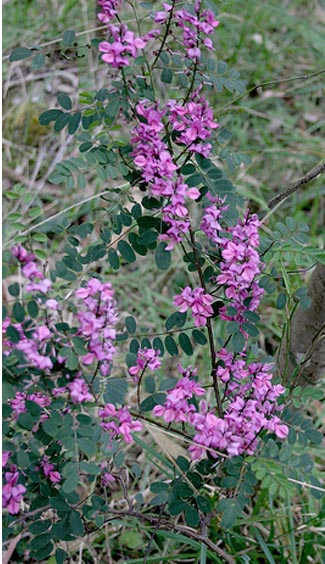
Pacific Northwest Medicinal Plant Guide (Check out all plants growing in Tryon Farm's medicinal garden!)
- Login to post comments



Huckleberry (Vaccinium spp.) Native
Huckleberry (Vaccinium spp.)
Parts used: fruit, leaves, bark
Medicinal uses: The juice of the berries was consumed as a beverage to stimulate the appetite or as a mouthwash. The leaves and bark were used in decoctions that were gargled for sore throats or inflamed gums (Pojar 57).
Other uses: The fruit was traditionally gathered by many Native American tribes in the Pacific NW. The fruit was an important source of vitamin C and was often dried and useful in trading. The foliage is relatively high in carotene and carbohydrates.
(http://extension.oregonstate.edu/warmsprings/huck.php).
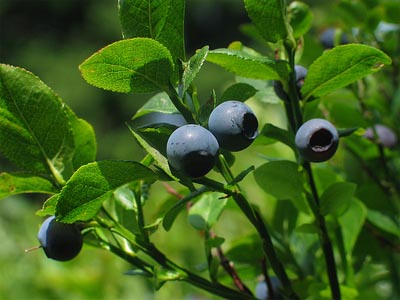
Pacific Northwest Medicinal Plant Guide (Check out all plants growing in Tryon Farm's medicinal garden!)
- Login to post comments



Hops (Humulus lupulus) Non-Native
Hops (Humulus lupulus)
Parts used: female flowers called strobiles either fresh or dried
Medicinal uses: The bitter principles contained in hops stimulate the digestive system increasing gastric and other secretions. Also contains sedative and astringent constituents as well. Hops relaxes smooth muscle and has an estrogenic effect. Hops is commonly used as a sedative and can reduce restlessness and irritability. It is also good for reducing stress, anxiety, tension, and headaches (Chevallier 106).
Additional uses: Commonly used to bitter beer. The cut and dried flower heads can be used in flower arrangements and wreaths. The flexible vine can also be used to weave baskets. The dried flowers can also be used as a stuffing in small pillows to help bring about sleep (Kowalchik 334).
Cautions: Do not use if suffering from depression (Chevallier 106).
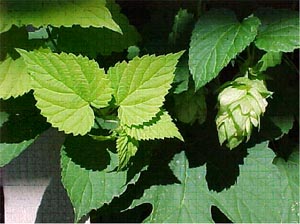
Pacific Northwest Medicinal Plant Guide (Check out all plants growing in Tryon Farm's medicinal garden!)
- Login to post comments



Honeysuckle (Lonicera spp.) Non-Native
Honeysuckle (Lonicera spp.)
Parts used: flowers, leaves, bark
Medicinal uses: Bark is diuretic and may be taken to relieve gout, kidney stones, and liver problems; leaves are astringent, useful for as a gargle and mouthwash for sore throats and canker sores; flowers are an antispasmodic and relieve coughs, traditionally taken to relieve asthma
Cautions: Do not take the berries as they are toxic (Chevallier 229).
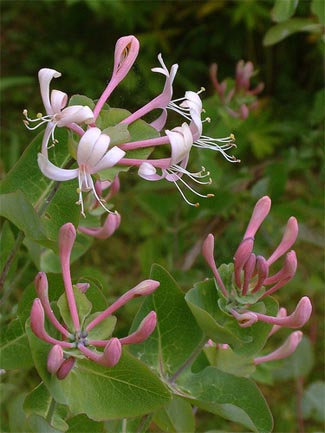
Pacific Northwest Medicinal Plant Guide (Check out all plants growing in Tryon Farm's medicinal garden!)
- Login to post comments



Hawthorne (Crataegus oxyacantha & C. monogyna) Non-Native
Hawthorne (Crataegus oxyacantha & C. monogyna)
Parts used: flowering tops and berries
Medicinal uses: This plant is a valuable remedy for high blood pressure, but also raises low blood pressure, giving the property of a cardiotonic. It can be used to treat angina and coronary artery disease. It improves heart function and is useful for mild congestive heart failure and irregular heartbeat.
Cautions: It is recommended to take this plant only under supervision (Chevallier 90).

Pacific Northwest Medicinal Plant Guide (Check out all plants growing in Tryon Farm's medicinal garden!)
- Login to post comments



Goldenseal (Hydrastis canadensis) Native
Goldenseal (Hydrastis canadensis)
Parts used: fresh and dried rhizome
Medicinal uses: Used by Native Americans as an insect repellant, it was also used as a lotion for wounds, ulcers, and inflamed eyes. It is commonly used today as an astringent, antibacterial remedy for the mucous membranes of the body. It also counters infection as an eyewash or mouthwash. Taken internally goldenseal increases digestive secretions, astringes the mucous membranes and checks inflammation. It should not be used for long periods of time though as it inhibits the gut’s capacity to absorb some nutrients, most notably B vitamins.
Cautions: This plant is toxic if taken in excess. Do not take if suffering from high blood pressure. Do not take while pregnant or breastfeeding (Chevallier 107).

Pacific Northwest Medicinal Plant Guide (Check out all plants growing in Tryon Farm's medicinal garden!)
- Login to post comments



Ginkgo (Ginkgo biloba) Non-Native
Ginkgo (Ginkgo biloba)
Parts used: leaves
Medicinal uses: Leaf extracts used to treat symptoms of various forms of cerebrovascular insufficiency and dementia, including memory loss, disturbed concentration, dizziness, sleep disturbances, mood swings, decreased stamina and debilitation. Used in Chinese medicine for over 2,800 years to strengthen heart and lungs.
Cautions: None known.
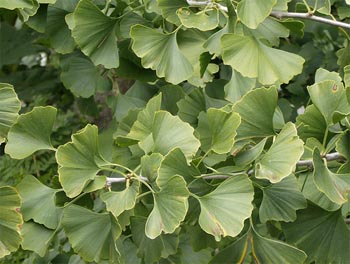
Pacific Northwest Medicinal Plant Guide (Check out all plants growing in Tryon Farm's medicinal garden!)
- Login to post comments



Garlic (Allium sativum) Non-Native
Garlic (Allium sativum)
Parts used: bulb (flowers are edible)
Medicinal uses: Garlic has been used since before the invention of antibiotics for the treatment of many infections from tuberculosis to typhoid. It was also used to dress wounds in the World War I. it is an excellent remedy for all types of chest infections. It is good for colds, flu, and ear infections, and it helps to reduce mucus. Digestive infections also respond well with garlic. It can also help rid the body of intestinal parasites. Garlic prevents circulatory problems and strokes by keeping the blood thin. It lowers cholesterol levels and blood pressure. Garlic may be taken to support conventional antibiotics and to ward off their side effects. It also reduces blood sugar levels and can help in late onset diabetes (Chevallier 59).
Additional uses: The dried flower heads can be used in flower arrangements. As a companion plant garlic is considered to help control pests, especially aphids (Kowalchik 218).
Nutritional information: An excellent source of vitamin B6. It is a very good source of manganese, selenium, and vitamin C. it is also a good source of phosphorus, calcium, potassium, iron, and copper (Murray 201).
Cautions: Use caution if taking hypertensive or blood thinning medication (Chevallier 59).
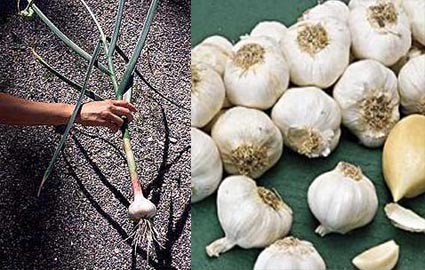
Pacific Northwest Medicinal Plant Guide (Check out all plants growing in Tryon Farm's medicinal garden!)
- Login to post comments



Fig (Ficus spp.) Non-Native
Fig (Ficus spp.)
Parts used: fruit, latex
Medicinal uses: Fruit sugars within the fig have a pronounced but gentle laxative effect (especially the dried fruit); syrup of figs is still a mild laxative remedy; the fruits emollient pulp helps relieve pain and inflammation, and has been used to treat tumors, swellings, and gum abscesses – the fruit is often roasted before application; also mildly expectorant and when used with herbs such as Elecampane can treat dry and irritable coughs and bronchitis; the milky latex from the leaves and stems is a reputed analgesic and has been used to treat warts, insect bites and stings
Nutritional information: They are recommended to nourish and tone the intestines due to their high fiber content. Figs are also naturally high in natural simple sugars, and minerals. They are fairly rich in potassium, calcium, magnesium, iron, copper, and manganese (Murray 275).
Cautions: The latex is toxic and should not be used internally. Applied to the skin, it may cause an allergic reaction to sunlight (Chevallier 211).
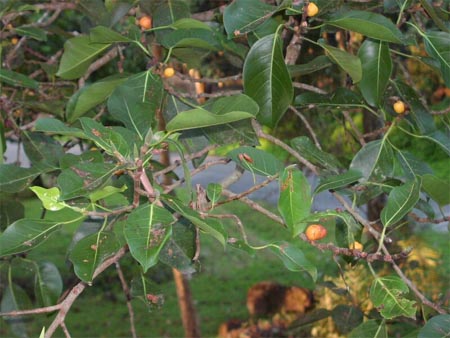
Pacific Northwest Medicinal Plant Guide (Check out all plants growing in Tryon Farm's medicinal garden!)
- Login to post comments



Feedback and participation welcome! Please send bug reports to web@tryonfarm.org







